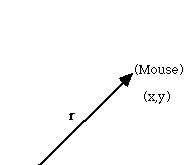
Vector Calculus I: Directional Derivatives
In calculus, we learned about the rate of change of a scalar function. E.g., if you know x(t) (position as a fn of time), the velocity is just dx/dt. Similarly, if you know a vector A(t), it has a derivative too:
dA/dt = i dAx/dt + j dAy/dt + k dAz/dt
This is also a vector:
Technically, dA/dt = lim(dt -> 0) (A(t+dt) - A(t)) / dt
Imagine tracking the position of a mouse running around the room:

The position (x,y) is a function of time. So,
r = i x + j y = i x(t) + j y(t)
(changes with time, i.e. r = r(t))
r is the "position vector" or "vector coordinate". What is the velocity of the mouse? The x velocity is dx/dt, the y velocity is dy/dt =>
v = dr/dt = i dx/dt + j dy/dt
Acceleration a = d2r/dt2 = i d2x/dt2 + j d2y/dt2
You can take derivatives of products. (If you forget these rules, or don't believe them, just write everything out component by component!)
d(c A)/dt = (dc/dt) A + c dA/dt
d(A.B)/dt = A.dB/dt + (dA/dt) . B (order doesn't matter in either of these, because c A = A c, and A.B = B.A)
d(A x B)/dt = A x (dB/dt) + (dA/dt) x B
(order DOES matter, keep A and B in the same order!)
A classic example: circular motion, constant speed.
(remember a = v2/r?)
r2= r.r = constant (because we're moving in a circle)
v2=v.v = constant (because speed = |v|=constant, and v2=|v|2)
Differentiate each of these:
d(r.r)/dt = r. dr/dt + (dr/dt).r = 2 r.dr/dt = 0 => r . v = 0 (1)
d(v.v)/dt = 2 v dv/dt = 0 => v.a = 0 (2)
Differentiate (1) again, to get r.dv/dt + (dr/dt) . v = 0, i.e.
r.a + v2=0 (3)
Conclusions: from (1), r . v = 0, so velocity is perpendicular to position. (Makes sense for circular motion - this is a much easier proof than the one usually used in 1110. See fig. below)
From (2) v . a = 0, i.e. acceleration is perp to velocity (again makes sense)
and then r.a + v2=0, but r and a are both perp to v, which means r and a must be parallel (or antiparallel), since this is all 2-D. Which means (again from (3))
r . a = |r| |a| cos(theta) = -v2.
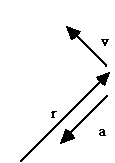
But I just argued that theta must be 0 or 180. Since the right side is negative, theta must be 180 to make the lhs negative too.
We conclude a is directed inwards (opposite of r), and also
-a r = -v2, i.e. a = v2/r
(These are all the facts you ever wanted to know about circular motion, just be differentiating a couple of vectors!)
How does all this work in polar coordinates?

Now we must be careful, because
 are changing, along with the particles position!
are changing, along with the particles position!
From the picture:

(convince yourself these equations are right!)

Ex: Suppose a particle's path is given by r(t) = constant,
 (this is uniform circular motion, again!)
(this is uniform circular motion, again!)

Same results as before! Bottom line: di/dt =0, but
 ,
so it's trickier to differentiate vectors when given in polar coords.
,
so it's trickier to differentiate vectors when given in polar coords.
Vector Fields -
Description of a vector quantity which varies in space.
(A "scalar field" is a scalar quantity which varies in space)
Examples of scalar fields: Temperature in room, Potential energy near earth. Examples of vector fields: Electric field (see below), Force, Fluid velocity...
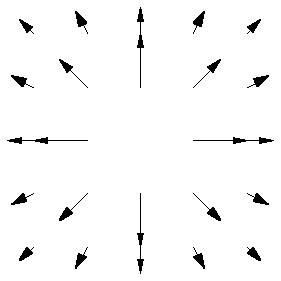
Vector fields are hard to draw!
(There is a value of the field at every point in a region of space)
E(x,y,t) = Ex(x,y,t)i+Ey(x,y,t)j
It's slightly easier to draw scalar fields defined in 2-D, by using the third dimension to show the *value* of the field. E.g, the potential (or potential energy) of the E-field of a point charge at different x-y points is V(x,y) = k Q/r:
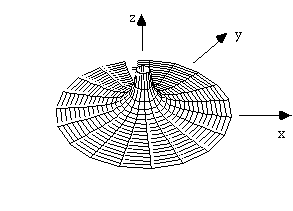
The circular contour lines are also equipotentials (Fixed V means constant radius in this case)
Partial Derivatives

(Reminder:
df/dx = lim(dx->0) [f(x+dx)-f(x)]/dx.
Think about the physical interpretation, as a slope! )
We will want to know about how functions or fields vary as you move in particular directions. If f = f(x,y), a function of x and y,
 is the change of f in the x direction, with y held constant, at some fixed
point (x0,y0). (The 2nd notation is a little weird, it doesn't mean the x
component of a vector. f here is not a vector, its a scalar function!)
is the change of f in the x direction, with y held constant, at some fixed
point (x0,y0). (The 2nd notation is a little weird, it doesn't mean the x
component of a vector. f here is not a vector, its a scalar function!)
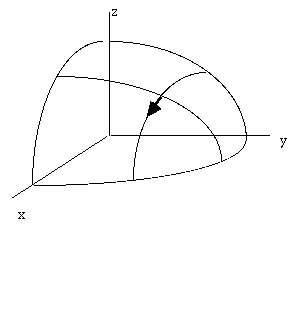
Think of plotting z = f(x,y), and the arrow here shows
Delta f / Delta x (at fixed y)
Example: f(x,y) = x2y-y2.
Partial of f (w.r.t.) x = 2 x y
Partial of f (w.r.t.) y=x2-2y
Or, our previous example, V = k Q / sqrt(x2+y2)
Partial of V (w.r.t.) y = k Q y/(x2+y2)(3/2) = (k Q/r)(y/r2)
When x gets bigger, r gets bigger, and the slope in the y direction gets less. (Look at the picture - it is generally less steep in the y direction when you are further from the origin)
Here is the Next lecture